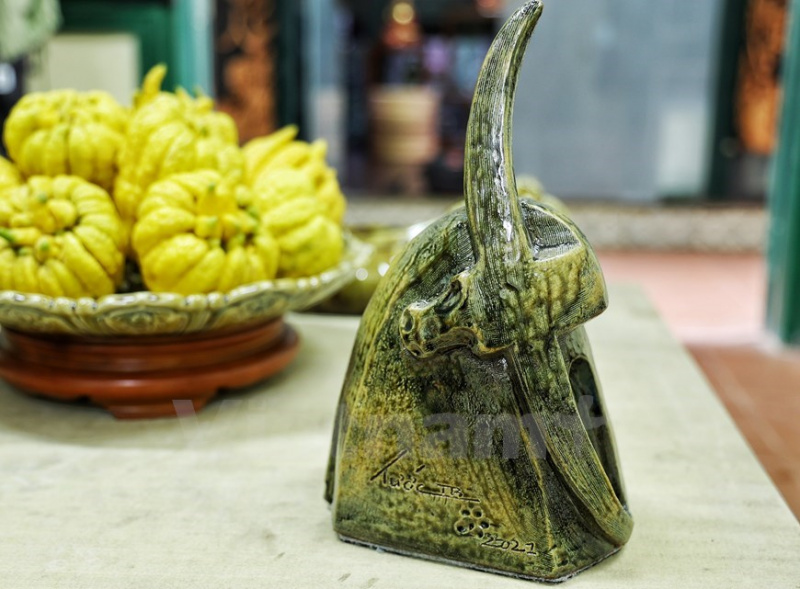 |
| (Photo: Vietnamplus) |
Artisan Tran Tuoc’s “Buffalo garden” collection consists of tens of artworks on buffalo, a familiar animal in Vietnam’s traditional culture and agricultural production.
With his creativity, the artisan wants to retrace a closer look of the second animal in the 12-year cycle of the Vietnamese zodiac in old stories and Buddhism. In the minds of many Vietnamese, the buffalo is associated with production and wealth creation. The artisan blows a fresher air to the buffaloes in the collection, making them closer to people, according to Vietnamplus.
 |
| Photo: Vietnamplus |
The buffalo is the traditional symbol of Vietnam, representing bravery, happiness, and prosperity. Buffalos also play a very important role in Vietnamese agriculture, being a farmer’s most valued possession and often treated as a member of the family.
The buffaloes are also a cultural symbol of the country. They have many qualities Vietnamese people appreciate, such as diligence, a gentle disposition, and loyalty, and can also symbolize powerful warriors.
 |
| Photo: Vietnamplus |
 |
| Photo: Vietnamplus |
Buffalo in art and culture of Vietnam
The buffalo is the traditional symbol of Vietnam, representing bravery, happiness, and prosperity. Buffalos also play a very important role in Vietnamese agriculture, being a farmer’s most valued possession and often treated like a member of the family.
 |
| Photo: Vietnamplus |
Not many people know that the buffalo also contributed greatly to the success of Vietnam’s revolution against foreign invaders. They were not only used to carry loads for farmers but also pulled carts of supplies for soldiers during wartime. Buffalos were an “undercover” means of transport, being able to walk on very poor roads, cross bridges and rivers, and climb steep hills.
It is not clearly known when the creature was first domesticated but buffalo fossils dating back tens of thousands of years have been found in caves in Lang Son, Hoa Binh Provinces in the north and Ha Tinh in the central region. Bovine bones have also been unearthed in Hai Phong, Hanoi, and Phu Tho. Archeologists think the Viet started to domesticate buffalos 5,000-6,000 years ago.
 |
| Photo: Vietnamplus |
Clay statues of buffalos are among the earliest artworks ever found in Vietnam, with many sculpted before the Common Era. Today well-off families like to hang buffalo heads and horns on walls as mementos of days past when their ancestors depended so much on these noble animals for survival.
Apart from their contribution to Vietnam’s economy and history, buffalo are also a cultural symbol of the country. They have many qualities Vietnamese people appreciate, such as diligence, a gentle disposition, and loyalty, and can also symbolise powerful warriors.
Buffalos appear in many stories about Vietnamese heroes, in Dong Ho paintings, at festivals, and in poetry as a symbol of a peaceful and prosperous life.
Buffalo in myths and history
 |
| Photo: Vietnamplus |
Most travelers to Hanoi know West Lake (Ho Tay) as an idyllic spot with luxurious restaurants. But few know its former name is Ho Trau Vang or golden buffalo lake.
Legend has it that after being cursed by a shaman, a golden buffalo ran from its hiding place in the Tien Du mountain of Bac Ninh Province to Hanoi where it stamped its feet and created a big hole. Hence the name.
Besides myths, the creature has its standing in history too.
Prior to becoming king, Dinh Bo Linh used to tend buffalos in the fields. Riding on one, the poor boy played generally with other kids in mock battles. It is probably on buffalo backs that the future leader learned his military tactics. He went on to defeat all 12 rival lords to unify the country.
There are other buffalo boys who made their mark, including Dao Duy Tu who became a feared military commander under Lord Nguyen Phuc Nguyen.
King Le Dai Hanh would show off his mighty army of buffalos to awe diplomats from China’s Song dynasty whenever they paid a visit.
The animals were also used as war machines. Drunk and with their tails set on fire, they would be herded en masse into enemy camps where they would set everything on fire.
Of the 15 tribes that made up the Van Lang Nation, there was one named Trau, or buffalo.
In art, the buffalo is the most popular animal, with the image of a young boy playing the flute on the back of one being the iconic and idyllic image of rural Vietnam.
Therefore, it is not by chance that this animal managed to find its way into the zodiac.



